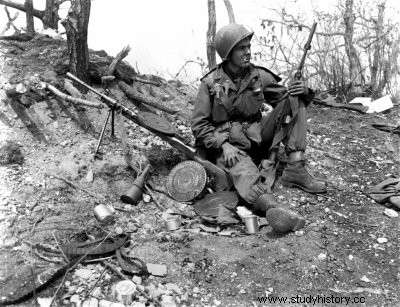
At this point, the heroic resistance of the 29th Free Brigade (of volunteers) represented the main obstacle to the Chinese advance. This epic Gloucesters defense on the Imjin broke their momentum. It crippled their advance for 3 days and eventually caused their collapse, allowing the UN forces to fall back in good order.
On April 25, the retreat movement stopped a few kilometers north of Seoul. The United Nations forces installed all around the South Korean capital a rampart of tanks, armored vehicles and guns, on which the Chinese launched, in vain, the bulk of their troops. Later flanking outflanking movements also failed. On April 29, a United Nations air fleet thwarted an attempt by 6,000 Chinese who were trying to reach Seoul by crossing the Han River estuary on ferries.
short:their offensive hesitated and then lost momentum. During this week, the Chinese lost 80,000 men to gain only 55 km of ground. United Nations casualties amounted to 7,000.
During the second phase of the Spring Offensive, which began on May 15, Chinese casualties reached an even more impressive 120 000 men. At the end of this offensive, on May 20, the toll of their sacrifice was as follows:South Korean 3rd Corps crushed at Inje; minimal territorial gains. They quickly lost these meager territorial advantages during the United Nations counter-offensive.
On May 30, United Nations troops were back on the "Kansas" line, which the 38th parallel. A few South Korean units, advancing towards the east coast with the support of naval artillery, reached Kangson, 55 km north of the 38th parallel.
A United Nations victory finally seemed imminent , but in June, the Chinese defense in the "Iron Triangle" hardened considerably. United Nations forces managed to seize Chorwon and Kumhwa on June 12, neutralizing the Triangle, but their pace began to flag.
It was then that, on June 23, Jacob Malik, representative of the U.S.S.R. at the United Nations, offered to start ceasefire talks. The negotiations, which began in Kaesong, on the 38th parallel, on July 10, dragged on because of the sterile quibbles of the Communist delegates. As a result, the Korean War did not officially end until July 27, 1953.
During the two years that the talks lasted, on the ground, the combat essentially took the form of brief but violent clashes. By one of these curious twists of fate, the communist forces in Korea increased considerably; their armies were transformed into a much more modern and better equipped battle corps. At the end of 1952, the number of Communist fighters was 800,000. They had the most modern Russian guns, including anti-aircraft batteries. But as the forces of the U.N. remained in control of the skies, the Communists could not take advantage of their potential. On the contrary, they were forced to wage a war of subsistence, aimed almost solely at protecting the circulation of the supplies necessary for their imposing army.
Since the end of 1950, when the first hunters to reaction Russian MiG.15s went into action, the Communists had vigorously attempted to wrest air control from the more competent and experienced UN pilots. The futility of this effort is evident in the tally of casualties. For 114 aircraft lost, the United Nations Air Force had destroyed or damaged
2,135 Communist aircraft including
838 MiG.15; figure not proven, but probable. During the last phase of the war, the proportion was 13 MiG.15 destroyed for 1F 86 American. The comparative figures for the loss of human life are no less disproportionate. Chinese and North Korean casualties were some 2,000,000 killed and wounded against about 383,000 for United Nations forces. The number of prisoners was 171,000 Communists and nearly 93,000 United Nations soldiers.
The Korean War gave no territorial advantage to the parties:at the end of hostilities, the border between the Communist North and the pro-Western South had hardly moved. But this war had taught both sides moderation.
Both sides could now assess with more precision and realism the adversary's determination to defend his interests and his ideas. Communist China, in particular, appeared as a new, more resolute entity, which it was necessary not to underestimate and no longer to consider from an outdated “colonial” perspective.
